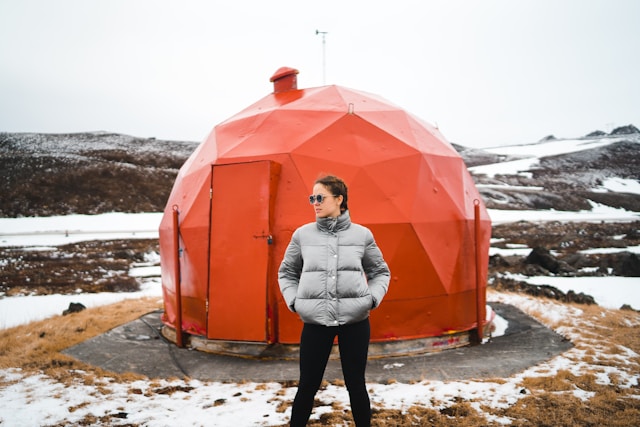Adventurous trip of Camping in Iceland Winter

Camping in Iceland during the winter is a unique experience, drawing adventurous travellers worldwide. With breathtaking landscapes, geothermal hot springs, and the possibility of witnessing the Northern Lights, winter camping in Iceland offers a chance to connect with nature in its most rugged form. But this experience requires careful planning, awareness of Iceland’s weather conditions, and some understanding of its camping culture. Here’s a guide to help you navigate your winter camping in Iceland journey.
Camping in Iceland is not a modern phenomenon. Historically, Iceland’s early settlers, primarily Norse Vikings, lived in close quarters with nature. Given the country’s challenging terrain and sparse resources, Icelanders traditionally embraced simplicity and self-sufficiency. Camping culture in Iceland grew after World War II, when roads and infrastructure improved, allowing more locals and international travellers to explore the island. Today, winter camping in Iceland has become a rite of passage for those who want to experience the island’s majestic beauty and Nordic wilderness in its rawest form.
Essential Tips for Camping in Iceland Winter
Winter camping in Iceland is rewarding but requires some preparation. Here are some essential tips to keep in mind before you head out on your Icelandic winter camping adventure:
- Choose the Right Campsites
- While Iceland has numerous campsites, only a few are open during winter. Campsites in popular destinations like Reykjavik, Vik, and Skaftafell remain open year-round and are equipped with heated facilities. Always check ahead to confirm if your intended campsite will be open.
- Pack for Extreme Cold
- Temperatures in Iceland can drop well below freezing during the winter, especially in the northern regions. Pack high-quality thermal layers, a windproof and waterproof outer layer, and a sleeping bag rated for extreme cold. Consider bringing a four-season tent to withstand Iceland’s strong winds.
- Invest in High-Quality Gear
- Camping in Iceland’s winter conditions requires durable gear. Lightweight tents may not withstand the harsh elements, so invest in a four-season tent. High-quality ground insulation, such as a thermal sleeping mat, can make a big difference in warmth.
- Stay Safe on Iceland’s Roads
- Winter in Iceland brings icy roads and snowstorms, making driving challenging. If you’re renting a camper van, ensure it’s equipped with winter tires, and drive cautiously. If you’re camping in Iceland winter conditions, having a vehicle with four-wheel drive (4WD) is highly recommended.
- Learn the Basics of Icelandic Weather
- Iceland’s winter weather is unpredictable and can change rapidly. Download the Icelandic weather app, Vedur, and check the forecast frequently to avoid extreme weather. Always check road conditions through the SafeTravel Iceland website, as some routes can be hazardous or even closed during the winter.
Must-See Sights for Camping in Iceland Winter
Camping in Iceland winter presents the chance to see some of the country’s most awe-inspiring sights without the summer crowds. Here are a few not-to-miss winter sights:
- The Northern Lights
- Iceland is one of the best places to see the Northern Lights, especially in winter when nights are long and dark. Head to locations away from city lights, such as Thingvellir National Park or the Snaefellsnes Peninsula, for the best viewing.
- Glacial Lagoons and Ice Caves
- Iceland’s glaciers, like Vatnajökull and Langjökull, are stunning in the winter. Guided tours of the glaciers and crystal-blue ice caves are a must-do activity. The famed Jökulsárlón Glacier Lagoon and nearby Diamond Beach are other incredible stops.
- Hot Springs and Geothermal Pools
- Winter camping in Iceland is made more enjoyable by visiting one of its many natural hot springs, such as the Secret Lagoon or Reykjadalur. Soaking in a hot pool surrounded by snow-covered landscapes is an experience unique to Iceland.
- Golden Circle
- The Golden Circle is a classic Iceland route that remains accessible year-round. Stops include Thingvellir National Park, the Geysir geothermal area, and Gullfoss Waterfall, all of which take on a magical appearance in winter.
Safety Precautions for Winter Camping in Iceland
Winter camping in Iceland can be an intense experience. To stay safe and have a memorable trip, consider these precautions:
- Be Prepared for Short Days
- In winter, daylight in Iceland is limited, with only a few hours of sunlight. Plan your activities carefully and avoid hiking or traveling long distances after dark.
- Bring a Portable Heater
- A portable camping heater can make a huge difference in comfort while winter camping in Iceland. Just make sure it’s safe for indoor use in confined spaces and ventilate properly to avoid carbon monoxide buildup.
- Keep Food and Water Supplies Handy
- Bring plenty of high-calorie, easily portable food, as cooking can be difficult in Iceland’s winter cold. Keep water from freezing by storing it in insulated bottles, and take advantage of Iceland’s clean natural water sources where possible.
- Register with SafeTravel Iceland
- Before you head out, register your travel plans with SafeTravel Iceland. This free service allows you to input your travel itinerary, helping rescue services locate you in case of an emergency.
Camping in Iceland winter offers a truly unique way to experience the island’s dramatic landscapes, rich history, and natural wonders. But remember, Icelandic winter weather can be unforgiving, so proper preparation is essential. From witnessing the Northern Lights to bathing in geothermal hot springs surrounded by snow, Iceland winter camping promises memories that last a lifetime.
So, pack your gear, choose your route carefully, and get ready for the ultimate adventure. Camping in Iceland winter is more than just a trip; it’s a journey into the heart of the Arctic wilderness.